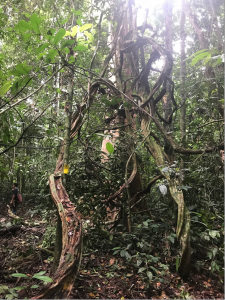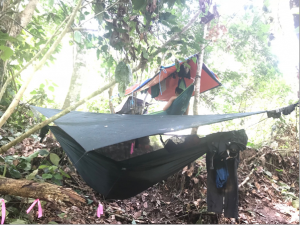
June 26, 2019, by lzzeb
Spatial patterns of lianas in Malaysia
A blog by Chris Chandler
Now in the third year of my PhD, a lot of my time has been spent in Malaysia (a total of 9 months) collecting data to understand the spatial patterns of lianas (climbing woody vines). Previous research has shown that lianas compete heavily with trees and can limit tree growth. In South and Central America (Neotropics) studies have also shown that lianas are increasing rapidly, relative to trees. This could have a huge impact on how much carbon trees are able to take up and store in the future. In Asia, on the other hand, we know very little about lianas: are they also increasing (similar to the Neotropics)? where do they occur? and what impact do they have on tree growth and carbon storage?
In order to understand spatial patterns of lianas and the impact on carbon storage I am attempting to map the distribution of liana infestation in tree canopies at a landscape-level. To do this, we use hyperspectral imagery collected by a plane which allows us to distinguish subtle differences in the spectral reflectance of trees vs lianas.
I travelled to Danum Valley, a protected area of primary and secondary forest, in Sabah, Borneo. Danum Valley Field Centre was primarily a research centre however the extensive diversity of flora and fauna now attracts many tourists each year.
Working in such an amazing environment for long periods of time I have managed to see a lot of weird and wonderful species. However, on a typical day (or week!), I may not see much at all. Working in a tropical forest is demanding and the need to walk quickly in order to reach forest plots and return again (combined with us probably not being overly quiet) means that spotting wildlife can be a challenge. However, you are frequently reminded by tourists of the many things you haven’t seen. For example, one group of four managed to sight 240 species of birds in the 4 days they were staying in Danum Valley (I think I saw one that day!).
Over the past three years I have set up around 30 forest plots, in which every tree has been identified and measured in order to calculate above ground biomass. I have also recorded the location of around 800 trees and the percentage of liana infestation in each canopy. This data can be used to build a model that can predict liana canopy cover across the entire landscape. Some of this data was collected not too far from the field centre however some data was collected much further away. This required camping deep in the forest for up to 5 nights. Camping in a tropical forest surrounded by nature is an amazing experience and so too was the food we created. Never have I had chicken curry mixed with sardines and anchovies…. For breakfast!
Over the past three years I’ve collected data directly for my PhD research, although last year we also made an exciting discovery in the process. I identified, using the airborne imagery, a tree with an estimated height of 98.9m. This tree was climbed in January this year [1] and was confirmed to have a height of 100.8m (to the lowest part of the buttress) making it the tallest tropical tree in the world [2]. The tree was named ‘Menara’, Malay for ‘tower’. The previous record holder for the worlds tallest tropical tree was another tree in Danum Valley estimated at 94.1m as well as a media report of a tree 96.9m tall in the Tawau Hills National Park in Sabah. Further analysis of the surrounding area suggested that the position of the tree, in a topographic low point with good access to water and sheltered by an adjacent ridge, provides ideal conditions to allow Menara to push the limits of maximum tree height [3].
[2] https://www.bbc.co.uk/news/uk-england-nottinghamshire-47830116
[3] Shenkin, A., Chandler, C.J., Boyd, D.S., Disney, M., Majalap, N., Nilus, R et al. (2019) The World’s Tallest Tropical Tree in Three Dimensions. Front. For. Glob. Change. DOI: 10.3389/ffgc.2019.00032
No comments yet, fill out a comment to be the first





Leave a Reply